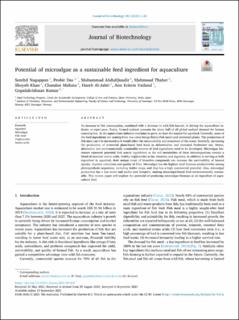| dc.contributor.author | Kumar, Gopalakrishnan | |
| dc.contributor.author | Nagappan, Senthil | |
| dc.contributor.author | Das, Probir | |
| dc.contributor.author | AbdulQuadir, Mohammad | |
| dc.contributor.author | Thaher, Mahmoud | |
| dc.contributor.author | Khan, Shoyeb | |
| dc.contributor.author | Mahata, Chandan | |
| dc.contributor.author | Al-Jabri, Hareb | |
| dc.contributor.author | Vatland, Ann Kristin | |
| dc.date.accessioned | 2021-11-14T15:02:57Z | |
| dc.date.available | 2021-11-14T15:02:57Z | |
| dc.date.created | 2021-11-12T11:07:02Z | |
| dc.date.issued | 2021-09 | |
| dc.identifier.citation | Nagappan, S., Das, P., AbdulQuadir, M. et al. (2021) Potential of microalgae as a sustainable feed ingredient for aquaculture. Journal of Biotechnology,, 341, 1-20. | en_US |
| dc.identifier.issn | 0168-1656 | |
| dc.identifier.uri | https://hdl.handle.net/11250/2829453 | |
| dc.description.abstract | An increase in fish consumption, combined with a decrease in wild fish harvest, is driving the aquaculture industry at rapid pace. Today, farmed seafood accounts for about half of all global seafood demand for human consumption. As the aquaculture industry continues to grow, so does the market for aquafeed. Currently, some of the feed ingredients are coming from low-value forage fishes (fish meal) and terrestrial plants. The production of fish meal can’t be increased as it would affect the sustainability and ecosystem of the ocean. Similarly, increasing the production of terrestrial plant-based feed leads to deforestation and increased freshwater use. Hence, alternative and environmentally sustainable sources of feed ingredients need to be developed. Microalgae biomasses represent potential feed source ingredients as the cell metabolites of these microorganisms contain a blend of essential amino acids, healthy triglycerides as fat, vitamins, and pigments. In addition to serving as bulk ingredient in aquafeed, their unique array of bioactive compounds can increase the survivability of farmed species, improve coloration and quality of fillet. Microalgae has the highest areal biomass productivities among photosynthetic organisms, including fodder crops, and thus has a high commercial potential. Also, microalgal production has a low water and arable-land footprint, making microalgal-based feed environmentally sustainable. This review paper will explore the potential of producing microalgae biomass as an ingredient of aquaculture feed. | en_US |
| dc.language.iso | eng | en_US |
| dc.publisher | Elsevier Ltd. | en_US |
| dc.rights | Navngivelse 4.0 Internasjonal | * |
| dc.rights.uri | http://creativecommons.org/licenses/by/4.0/deed.no | * |
| dc.subject | akvakultur | en_US |
| dc.subject | fiskefõr | en_US |
| dc.title | Potential of microalgae as a sustainable feed ingredient for aquaculture | en_US |
| dc.type | Peer reviewed | en_US |
| dc.type | Journal article | en_US |
| dc.description.version | publishedVersion | en_US |
| dc.rights.holder | © 2021 The Author(s) | en_US |
| dc.subject.nsi | VDP::Matematikk og Naturvitenskap: 400 | en_US |
| dc.source.pagenumber | 1-20 | en_US |
| dc.source.volume | 341 | en_US |
| dc.source.journal | Journal of Biotechnology | en_US |
| dc.identifier.doi | 10.1016/j.jbiotec.2021.09.003 | |
| dc.identifier.cristin | 1953996 | |
| cristin.ispublished | true | |
| cristin.fulltext | original | |
| cristin.qualitycode | 1 | |

